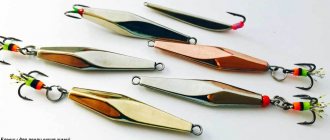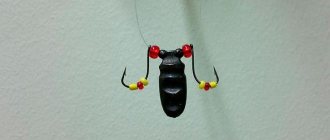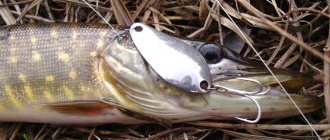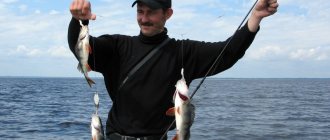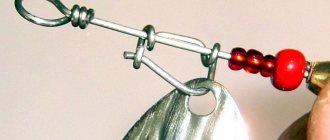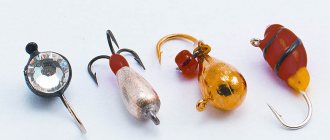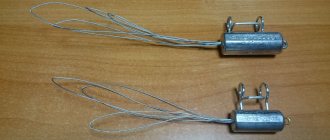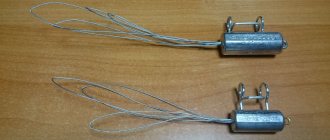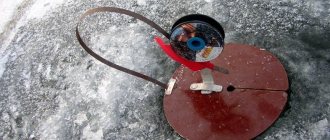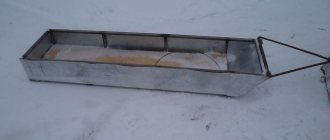When should you choose store-bought ones and when should you choose homemade ones?
It’s no secret that winter vertical spinners from well-known home-made masters often outright beat branded spinners, even expensive Finnish ones. But at the same time, they cost much more than branded products. High-quality homemade products can give a head start to branded baits when catching bass in any specific conditions or when trying to catch a passive predator.
Therefore, you should fish with store-bought bait when the perch bite is quite stable. If a predator is capricious, then it is advisable to use good, expensive homemade products. And during periods of “distribution” you can fish with rather primitive baits made from scrap materials.
Expert opinion
Knipovich Nikolai Mikhailovich
Zoologist, hydrobiologist. I am interested in fishing at a professional level.
Even a high-quality spinner in inept hands will not show even a small fraction of its capabilities. In order for a spinner to successfully catch perch, the angler must understand how to give it the desired action, and the gear must match the fishing conditions.
A little history
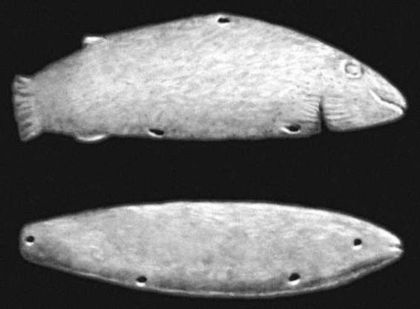
Even in ancient times, people understood that an object moving underwater lured a predator and began to use it to make bait until they learned how to mine metal.
- stone,
- tree,
- animal bones.
Nowadays there is no such need, since fishing stores sell a lot of different catchable baits made in a factory.
And yet, passionate, inquisitive people prefer to make lures for perch with their own hands.
Advantages and disadvantages of homemade baits for perch fishing from ice in winter
“Home-made” spinners for winter perch hunting have the following advantages:
- low cost of baits;
- high catchability of high-quality spinners;
- ease of making spinners from scrap materials;
- the ability to manufacture baits for specific fishing conditions;
- creativity of the process of making baits with your own hands.
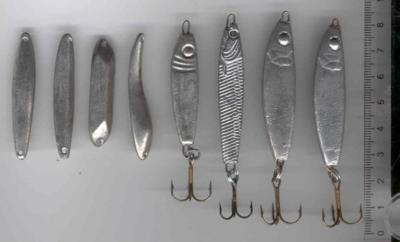
At the same time, homemade baits have the following disadvantages:
- the complexity of manufacturing high-quality spinners, since special tools and equipment are required;
- insufficient catchability of easy-to-make baits;
- instability of the work of spinners made “on the knee”.
Types of baits
Perch is one of the most voracious fish in winter. If in summer few people are interested in catching bass, preferring to hunt larger predators, then in winter the handsome striped fish is a desired trophy for any fisherman . He readily takes on both a regular jig and special spinners.
Those who decide to catch a larger perch think about how to get it from the depths of the reservoir. For this purpose, you need heavy baits that quickly reach the bottom. Ice fishing enthusiasts purchase them in stores. However, many people make homemade winter lures, which are not inferior in catchability to their factory-made counterparts.
In addition to weight, baits differ in size and shape of the spoon. To catch small perch, they use light home-made perch, and for large ones, they take heavier and more reliable gear.
Lures can be very diverse in shape: prismatic, oval, round, voluminous, flat, curved, ribbed, oblong, and so on.
Bait for predators is also distinguished by the presence of various hooks. In perch fishing, one hook is mainly used, although there are tackles with two hooks . The hooks themselves can be single, double, triple and even quadruple.
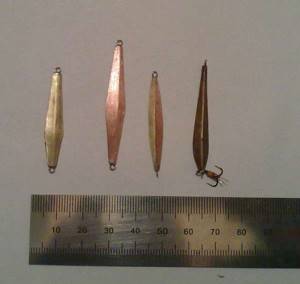
A good spinner, like a good fashionista, loves attractive accessories. These include various cambrics, fabric and plastic fish tail simulators, color spots on the cavity of the spoon, and other decorations.
On the modern market there is a huge amount of gear and bait for every taste, so inexperienced fishermen do not want to strain and make a spinner for winter fishing with their own hands. Such a spinner will bring additional bonuses to the angler’s self-esteem. After all, all the fish caught will be 100% the merit of a skilled master not only of fishing, but also of the manufacturer of the main tool for this business.
Kinds
Lures for vertical trolling of perch can be divided into the following categories according to the type of game:
- Nail spinners. Lures that practically do not deviate from the vertical axis, i.e. after reset, they immediately return to their original position.
- Gliding lures. After the reset, the bait moves to the side and then gradually returns to its original position.
- Spilling spinners. After being dropped, the bait falls, waddling from side to side.
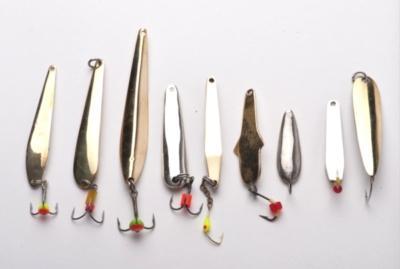
According to the equipment with hooks, vertical lures for perch can be divided into the following categories:
- Spoons with a soldered single thread. Usually these are small baits for hunting perch in shallow water.
- Spoons with a soldered double. Quite common options.
- Spoons with a soldered tee. Rarely found items.
- Spoons with hanging tee.
- Lures with a single or triple hook on a chain.
Expert opinion
Knipovich Nikolai Mikhailovich
Zoologist, hydrobiologist. I am interested in fishing at a professional level.
Almost all spinners for vertically trolling perch from the ice have an additional decoration on the hook, which serves as an “attack point” for the striped robber. On lures with soldered hooks, these are red woolen threads or the shank of the hook is simply painted in a bright color. Hanging treble hooks are usually equipped with a multi-colored drop.
The following materials are used for making winter lures for perch:
- copper;
- brass;
- cupronickel;
- beryllium bronze;
- stainless steel;
- tin;
- lead;
- solder;
- babbitt.
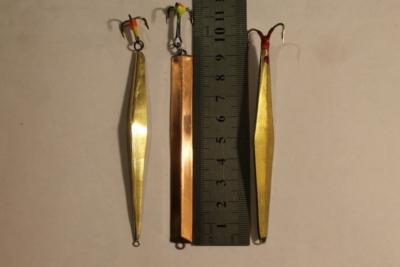
their different sides are made of different metals. The most famous homemade spoons, which provide serious competition to store-bought baits, are the following:
- rhombuses of various modifications;
- sleepers;
- petals;
- trihedrons;
- maropedki.
Expert opinion
Knipovich Nikolai Mikhailovich
Zoologist, hydrobiologist. I am interested in fishing at a professional level.
The manufacture of these baits requires precise drawings, punches and a variety of equipment.
At the same time, it is possible to make some homemade spinners from scrap materials, sometimes literally “on the knee”.
Homemade vertical perch spoons
The photo shows a drawing and appearance of a homemade vertical perch spoon, suitable for catching perch on a line with a diameter of 0.15-0.16 mm at depths of up to 3-3.5 meters in a reservoir without a current.
But the same perch spoon will cease to be working even in moderate currents with the same fishing line thickness.
The ratio of length to width of a vertical homemade perch bait is 5/1. Divide 43 mm of length by 8.5 mm of the maximum width of the spoon.
The length of the complete lower autonomous homemade wiring is approximately half a meter.
What is printed from the title of the article to this place is an important characteristic of a homemade perch vertical spoon with the bait tied to a winter fishing rod equipped with a fishing line with a diameter of up to 0.16 mm.
To catch perch at a greater depth without a current, up to 4 meters, or at the same depth, but in a weak current without very noticeable changes in the game of the same homemade perch vertical spoon, we will have to reduce the diameter of the fishing line to 0.12-0.13 mm.
The reasons are discussed in the article Choosing a perch spoon for fishing depth
For catching perch in a decent current, where sometimes a large humpback whale waits for its prey behind shelters, this homemade perch spoon has a small weight. The bait will simply be carried away by the current several meters from the hole before it can be found to the bottom.
The total length of the lower wiring for a homemade perch spoon of this system is about half a meter. This means that you can hold the bait plumb in the shallows only at depths above the specified value. Next, in a short video, you can watch the testing of homemade perch lures.
How to make the best catchable bait for winter fishing: instructions and drawings
From a spoon
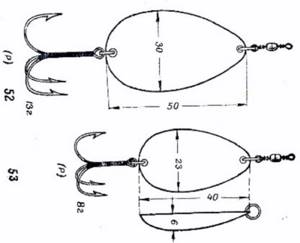
To make a winter spinner from a spoon you will need the following:
- Materials:
- dessert cupronickel or silver spoon;
- winding rings;
- treble hook.
- Tools:
- hacksaw for metal;
- file;
- needle files;
- drill;
- pliers.
Step-by-step instructions for making a spinner from a spoon are as follows:
- The handle or handle is cut off from the spoon.
- Process the edges of the cuts.
- Drill holes in the front and back of the workpiece.
- The spoon is equipped with winding rings and a tee.
- They give the spoon a bend, thereby achieving the necessary game.
Expert opinion
Knipovich Nikolai Mikhailovich
Zoologist, hydrobiologist. I am interested in fishing at a professional level.
From a seemingly unnecessary part of a spoon or “slurp” you can make a catchy oscillating spoon for fishing in open water. To do this, two holes are also drilled and the workpiece is equipped with rings and a tee.
From a beer can
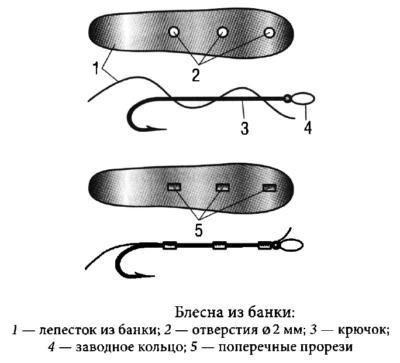
An empty can of beer, soft drink or canned food can also serve as material for making a winter lure for catching perch. An aluminum can must be used. The result is light spinners for fishing in shallow water.
To make such a spinner you will need the following:
- Drawing. The drawing shows the shape and dimensions of the future spinner. Then the outline of the workpiece is cut out of paper.
- Materials:
- empty jar;
- winding rings;
- treble hook.
- Tools:
- metal scissors;
- awl;
- hammer;
- file;
- sandpaper;
- soldering iron
How to make a spinner from a can:
- Cut the can and level the sheet with a hammer.
- Apply a pattern with the outline of the spoon and trace it with an awl.
- Cut out the workpiece.
- The edges and surface of the workpiece are processed.
- Two holes are pierced: in front and behind the workpiece.
- Give the spoon the desired bend by attaching the workpiece to some round object, for example, a wooden rolling pin.
- The lure is equipped with rings and a tee.
- If you need to make the lure heavier, a layer of solder is soldered onto the inner surface.
Expert opinion
Knipovich Nikolai Mikhailovich
Zoologist, hydrobiologist. I am interested in fishing at a professional level.
A spinner with a soldered single hook can be no less effective. Then to make the bait you will additionally need solder, phosphoric acid and a soldering iron.
From tweezers
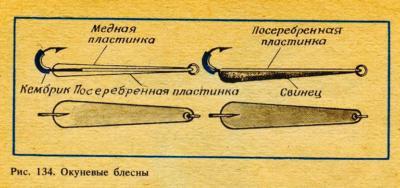
Tweezers make nail-type spoons or jigs. You can make a large bait from medical tweezers or a small one from a tool used by radio amateurs and electronics engineers. A drawing for making such a bait is not required, but this is what is needed:
- Materials:
- metal tweezers;
- winding rings;
- treble hook.
- Tools:
- hacksaw for metal;
- file;
- needle files;
- sandpaper;
- drill;
- pliers.
Making a winter spinner for catching perch using tweezers is carried out as follows:
- A workpiece of the required length is cut out of tweezers, and 2/3 of it should have a smooth surface, and 1/3 should have a grooved surface.
- The workpiece is processed.
- Drill holes.
- The lure is equipped with rings and tees.
- They bend the spoon so that it plays as needed.
Castmaster
Anglers who tried ice fishing with the famous Castmaster from the American company Acme were amazed at its catchability.
Expert opinion
Knipovich Nikolai Mikhailovich
Zoologist, hydrobiologist. I am interested in fishing at a professional level.
However, the cost of the original spinner is noticeably on your pocket, and making a homemade Castmaster is not so difficult.
There are two ways to make this bait: from a solid metal rod and from a tube.
To obtain bait from a solid rod you will need the following:
- Drawing. The drawing indicates the size of the bait and, most importantly, the cutting angles, which should be 17 and 23 degrees for the resulting lure to resemble the original.
- Materials:
- Metal rod of the required diameter. Materials: copper, brass or stainless steel.
- Wind-up rings.
- Treble hook.
- Tools:
- hacksaw for metal;
- protractor;
- file;
- sandpaper;
- drill.
How to make a homemade Kastmaster:
- Cut the workpiece, observing the cutting angles.
- Process the workpiece.
- Drill holes for the rings.
- The spoon is equipped with winding rings and a tee.
If you intend to make a spinner out of a tube, you will have to stock up on tin or lead. Having cut the blank from the tube, tin or lead is poured into it, and then the holes are drilled and the spoon is equipped with winding rings and a tee.
Expert opinion
Knipovich Nikolai Mikhailovich
Zoologist, hydrobiologist. I am interested in fishing at a professional level.
However, for fishing at shallow depths, you can use a hollow tube spoon.
Rotating
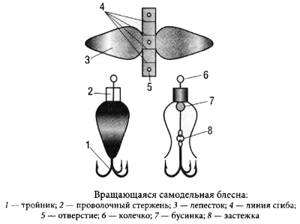
A vertical spinner for catching perch from ice can rotate around its axis during the pause following the release. Some symmetric trihedrons have a similar game. The secret of production is known only to their designers.
From an electrical cable
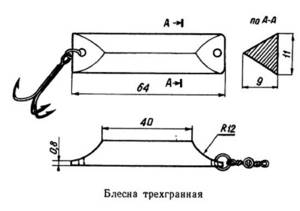
- Materials:
- a piece of electrical cable with a diameter of 1 cm and a length of 6-7 cm;
- winding rings;
- treble hook.
- Tools:
- hacksaw for metal;
- file;
- sandpaper;
- drill.
The process of making a spinner from a cable looks like this:
- Saw off the workpiece to the required length.
- Grind down the edges.
- Drill holes.
- The lure is equipped with rings and a tee.
"Malek"
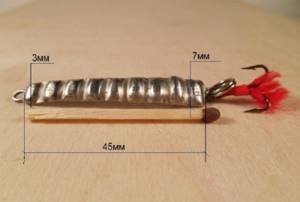
The Malek spinner is a rather original product, which has no analogues among store-bought spinners. What is needed to make it?
- Drawing. To make it easier to make a spinner, first draw a drawing. The length of the spinner is usually 5 cm, the width at the front end is 3 mm, at the rear end it is 8 mm.
- Materials:
- corrugated metal plumbing pipe;
- winding rings;
- treble hook.
- Tools:
- metal scissors;
- file;
- grinding paste;
- drill.
Such a spinner is made as follows:
- Cut out a pattern from thick paper or cardboard.
- Cut the pipe lengthwise and cut out a piece of approximately the required size.
- Having applied the pattern, the workpiece is sawed off from the pipe.
- Process the workpiece.
- Drill holes.
- The lure is equipped with rings and a tee.
Expert opinion
Knipovich Nikolai Mikhailovich
Zoologist, hydrobiologist. I am interested in fishing at a professional level.
Due to the transverse ribs, the Malek has a unique game, which makes it extremely catchy.
"Dovetail"
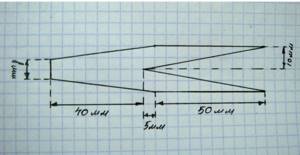
“Dovetail” is a much more complex design, which, however, does not require the use of dies and punches. To make it you will need:
- Drawing. A pattern is cut out 90 m long and 30 mm wide with a tail cutout of 25 mm.
- Materials:
- sheet copper;
- orthophosphoric acid;
- solder;
- single hook;
- thin copper wire.
- Tools:
- metal scissors;
- file;
- soldering iron;
- awl;
- sandpaper.
Dovetail is made like this:
- Cut out the blank according to the template.
- Solder the workpiece from the inside.
- Using an awl, draw a straight line through the middle and bend the workpiece in half lengthwise.
- The tail processes are brought together, forming something like a boat, and soldered together.
- Make a loop of wire and solder it from the inside at the front of the workpiece.
- Solder the hook at the back of the workpiece.
- Fill the internal space with solder.
- Processing the spinner.
"Torpedo"

You will need the ability to solder and give the lure the desired shape using a matrix. To make a Torpedo you will need the following:
- Drawing. On thick paper, draw the outline of the future spinner, resembling an elongated overturned drop. For fishing at shallow depths, the spoon has the following dimensions: length 50 mm, width at the top 10 mm, width at the bottom – 3-5 mm. If you plan to fish at greater depths, the dimensions are proportionally increased.
- Materials:
- sheet of non-ferrous metal;
- wooden block;
- orthophosphoric acid;
- solder;
- copper wire;
- winding ring;
- treble hook.
- Tools:
- metal scissors;
- soldering iron;
- rubber hammer;
- sandpaper;
- file.
The manufacturing process of the Torpedo is as follows:
- A recess of the desired shape is made in a wooden block.
- Cut out two sides of the future spinner.
- Give them the required shape.
- Loops are soldered from the inside.
- Fill the space between the two edges with solder and solder them together.
- The workpiece is processed and polished.
- The spoon is equipped with a winding ring with a tee.
Making other homemade spinners requires even more skill.
Unhooked

A non-hooking spinner can be made from any bait with a hanging hook, replacing the latter with a tee with a wire protection, which can be purchased at a fishing store. However, small hooks can be difficult to find. We can recommend using an offset hook with a small twister attached to it.
It has been customary for a long time to use homemade lures for perch for winter fishing. This was not due to a good life, since it was unrealistic to purchase a more or less catchy lure in a store in Soviet times.
Today, making homemade lures for catching perch from ice has become a separate area of the fishing business, but if desired, any angler can make a simple bait from scrap materials and successfully catch striped robbers with it.
Spoons for perch
Lures for catching perch are made from different materials, but copper or brass is most often used.
First option. A small trapezoid is cut out of a sheet of metal: the width of the lower part is 9-10 mm, the width of the upper part is 6-7 mm, the length is 40-50 mm.
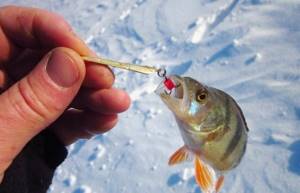
Next, you need to delicately round the corners of the plate, which will require a file. Then, using a hammer or vice, the workpiece is given the desired “boat” shape. The cavity of the future bait is filled with a lead-tin alloy, so this procedure requires a soldering iron and solder.
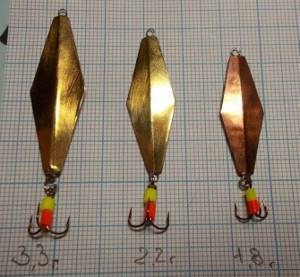
After this, in the upper and lower parts you need to drill two holes with a diameter of approximately 2 mm, through one of which a winding ring with a triple hook is then mounted, and the other will serve to attach the fishing line. At the final stage, the hook is usually “decorated” with red cambric in order to increase the attractiveness of the bait for striped predators.
